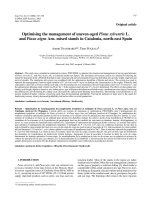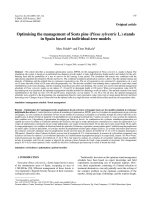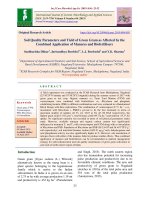Eco-friendly management of powdery mildew of green gram (Vigna radiata L.)
Bạn đang xem bản rút gọn của tài liệu. Xem và tải ngay bản đầy đủ của tài liệu tại đây (143.74 KB, 5 trang )
Int.J.Curr.Microbiol.App.Sci (2017) 6(7): 435-439
International Journal of Current Microbiology and Applied Sciences
ISSN: 2319-7706 Volume 6 Number 7 (2017) pp. 435-439
Journal homepage:
Original Research Article
/>
Eco-Friendly Management of Powdery Mildew
of Green Gram (Vigna radiata L.)
Rajesh Kumar Yadav1*, S.S. Kakraliya2, M.R. Bajiya3 and Sonali Abrol2
1
Department of Plant Pathology, Sam Higginbottom Institute of Agriculture, Technology and
Sciences (Deemed-to-be-University), Allahabad-211007, Uttar Pradesh, India
2
Division of Plant Pathology, 3Division of Entomology, SKUAST-Jammu, India
*Corresponding author
ABSTRACT
Keywords
Carbendazim,
Erysiphe polygoni,
Pseudomonas
fluorescens,
Trichoderma
viride,
Trichoderma
harzianum, Plant
extracts.
Article Info
Accepted:
04 June 2017
Available Online:
10 July 2017
The present study was conducted during consecutive Kharif season of 2014-2015. An
experiment was conducted to evaluate the efficacy of selected fungicide, bio-agents,
botanicals against powdery mildew (Erysiphe polygoni). To manage the disease on
investigation was carried out in the Department of Plant Pathology, SHIATS- DU,
Allahabad to evaluate the efficacy of bio-agents viz., Pseudomonas fluorescens @ 2%,
Trichoderma viride @ 2.5%, Trichoderma harzianum @ 2.5%, plant extracts viz., neem
leaf extract @ 10%, garlic clove extract @ 10% and fungicide viz., Carbendazim @ 0.1%
against powdery mildew (Erysiphe polygoni). In-situ (field) experiment was carried out in
randomized block design with seven treatments and three replications. T. viride @ 2.5%
was found to be most effective treatment and recorded minimum disease intensity
(15.98%) followed by Pseudomonas fluorescens @ 2% (18.04%), T. harzianum @ 2.5%
(20.26%), neem leaf extract @ 10% (21.55%), garlic clove extract @ 10% (22.87%) and
fungicide viz., Carbendazim @0.1% (14.27%). Use of T. viride @ 2.5% (65.99 cm)
recorded maximum plant height (42.62 cm and 65.99 cm at 45 and 75 DAS, respectively).
Maximum number of pods was recorded in T. viride (13.30 and 14.27, respectively)
followed by P. fluorescens (13.00% 14.07%, respectively) as compared to control which
reordered minimum number of pods per plant (8.50 and 9.60, respectively). The highest
seed weight (g/plot) was recorded in T.viride (37.95 g) followed by P. fluorescens (37.47
g) as compared to T0).
Introduction
are known to reduce several noncommunicable diseases such as colon cancer
and cardio- vascular diseases. Production
followed by pigeon pea (18-20%), mungbean
(11%), urdbean (10-12%), lentil (8-9%) and
other legumes (20%) (Laxmipathi et al.,
2013). Green gram is grown mainly as a
kharif season crop. However, its cultivation in
Rabi season is restricted to the eastern and
southern parts of the country. The major
Mungbean (Vigna radiate L.), belongs to the
family leguminosae and sub family
Papilionaceae. Pulses are major sources of
proteins among the vegetarians in India, and
complement the staple cereals in the diets
with proteins, essential amino acids, vitamins
and minerals. They contain 22-24% protein,
which is almost twice the protein in wheat
and thrice that of rice. Pulses provide
significant nutritional and health benefits, and
435
Int.J.Curr.Microbiol.App.Sci (2017) 6(7): 435-439
green gram growing states are Orissa,
Madhya Pradesh, Maharashtra, Uttar Pradesh,
Andhra
Pradesh,
Rajasthan,
Punjab,
Karnataka and Gujarat. It ranks third among
all pulses grown in India after chickpea and
pigeon pea. Orissa stands first in area,
production as well as productivity of green
gram in India. It is followed by Maharashtra,
and Madhya Pradesh in area and production.
The crop is generally grown during Kharif as
rainfed crop. Among the diseases, powdery
mildew caused by Erysiphe polygoni is one of
the economically important diseases in green
gram which occur at later stages of crop
growth. Grain yield losses have been reported
up to 21% due to powdery mildew in green
gram (Quebral and Cowel 1978). Losses are
much high when the pathogen infects the crop
before flowering, however, it results in
complete loss of the crop if disease occurs at
seedling stage. Abbaiah (1993) reported that
the powdery mildew in Urdbean was
generally noticed in 45 days old crop.
Similarly, Venkata Rao (1997) observed that
40 and 50 days old green gram plants were
highly susceptible to powdery mildew
covering the entire leaf surface. The fungus is
an obligate parasite that requires living hosts
to complete their life cycle.
Materials and Methods
In-situ experiment
In situ experiment (field) was laid out in
randomized block design (RBD) with seven
treatments Viz. Carbendazim @0.1%,
Pseudomonas fluorescens @2%, Neem leaf
extract @ 10%, Garlic clove extract @ 10%,
Trichoderma viride @ 2.5% Trichoderma
harzianum @ 2.5% and three replications
including
inoculated
check
in
the
experimental field of SHIATS, Allahabad in
kharif season (2014-2015). Each replication
consisted of 21 plots of 2×1m2 each. The
seeds cv. “T- 44” was sown in February with
a spacing of 10 x 45cm. Bioagent and
botanicals were sprayed just after initiation of
disease and repeated three at 15 days interval.
Plots without sprays server as check the
observations were recorded in five selected
tagged plants 3 days after last sprays of
botanicals using 0 to 9 grade scale (Kapadiya
and Dhruj, 1999) (Table 1). The data was
subjected to the statistical analysis.
The disease first appears on the leaves; in its
advanced stage, stems and pods become
infected, resulting in yield loss. The disease
reduced yield of green gram between 21 and
40 per cent (Soria and Quebral, 1973) in the
Philippines and up to 40 per cent in Taiwan
(AVRDC, 1984). Powdery mildew occurs
under cool temperatures (22 °C to 30 °C) and
is favoured by cloudy weather. Powdery
mildew is easily recognized white, powdery
growth of the fungus on infected portions of
the plant host. The powdery appearance
results from the superficial growth of the
fungus as a thread-like stands (hyphae) over
the plant surface and the production of chains
of spores (conidia). In the early stages of
infection, light yellowish, irregular spots
appear on the leaves, which rapidly turn
brown. A powdery mass grows over the spots
Preparation of fungicidal spray solution
The spray solution of a desired concentration
was prepared by adopting the following
formula.C×A
V = -----------% a.i
Where,
V = Volume/weight of commercial fungicide
ml or g
C = Concentration required
A = Volume of solution to be prepared
436
Int.J.Curr.Microbiol.App.Sci (2017) 6(7): 435-439
% a.i. = percentage of active ingredient in
commercial product
pod per plant was recorded in T5 Trichoderma viride @ 2.5% (7.44%) as
compared to treated and untreated control
(7.76% and 5.57% and respectively). T5 Trichoderma viride treatment was followed
by T2- Pseudomonas fluorescens @ 2.5%
(7.10%), T3- Neem leaf extract @ 20%
(7.07%), T6 - Trichoderma %
(6.87%) and T4 - Garlic extract @ 10%
(5.95%) as compared to T0 - control (5.95%).
Among the treatments No of pod per plant of
mung bean was recorded in T1- Carbendazim
50 WP @ 0.1% (7.76%) and T5 Trichoderma viride @ 2.5% (7.44%).
Disease intensity (%) was calculated by
using the following formula
Sum of all disease ratings
Disease intensity (%)
Disease intensity (%) = ……………… x 100
Total number of leaves/plant x
Maximum disease grade
Results and Discussion
The result presented in table 2 revealed that
all the treatments were statistically significant
and increased plant height as compared to
control. Among the bio agents and botanicals
the maximum plant height (cm) was recorded
in T5 – Trichoderma viride @ 2.5% (65.99
cm) followed by T2 - Pseudomonas
fluorescens @ 2% (65.10 cm), T6 Trichoderma harzianum @ 2.5% (64.15cm),
T1- Carbendazim @ 0.1% (63.13), T3-Neem
leaf extract @ 10% (62.11 cm), T4- Garlic
extract @ 10% (61.88cm), as compared to T0
control (59.53cm).Among the treatments
maximum plant height (cm) in T5 –
Trichoderma viride (65.99 cm). The bio
agents and botanicals the minimum number of
The results presented in table 2 revealed that
all the treatments were statistically significant
and decreased disease intensity as compared
to control. Among the bio-agents and
botanicals used the maximum plant height
was recorded in T5 Trichoderma viride (65.99
cm) as compared to treated and untreated
controls (63.13and 59.53cm respectively)
(Plate 1). minimum disease intensity percent
was recorded in T2- Pseudomonas
fluorescens @ 2% (18.04%) as compared to
treated and untreated control (20.15% and
14.27%and respectively).
Table.1 Different treatments
Treatments
Treatment name
T0
Untreated Control
T1
Carbendazim @ 0.1% (treated control) (FS)
T2
Pseudomonas fluorescens @2% (FS)
T3
Neem leaf extract @ 10% (FS)
T4
Garlic clove extract @ 10%, (FS)
T5
Trichoderma viride @ 2.5% (FS)
T6
Trichoderma harzianum @2.5%
FS = foliar spray
437
Int.J.Curr.Microbiol.App.Sci (2017) 6(7): 435-439
Table.2 Per cent disease intensity of Erysiphe polygoni and plant growth of green gram at 60
DAS as affected by different treatments
Treatments
T0
Untreated control
T1
Carbandazim
(treated control)
T2 Pseudomonas
fluorescens
T3
Neem leaf extract
T4
Garlic extract
T5
Trichoderma
viride
T6
Trichoderma
harzianum
SEd (±)
CD at 5%
Plant
height
(CM)
DAS
59.53
No.
of Disease
pod per intensity
60 plant
DAS
100020 seed
weight
(g/plot)
31.78
Yield
(q/ha)
C:B ratio
5.30
1:1.14
5.57
40.57
63.13
7.76
14.27
38.84
9.50
1:2.00
65.10
7.10
18.04
37.47
7.80
1:1.63
62.10
7.07
21.55
36.07
7.40
1:1.58
61.88
5.95
22.87
35.81
6.90
1:1.45
65.99
7.44
15.98
37.95
8.70
1:1.83
64.15
6.87
20.26
36.38
7.60
1:1.60
1.05
2.30
0.10
0.57
0.76
1.66
0.71
1.56
0.06
0.14
-
T2- Pseudomonas flourescens treatment was
followed by T5 – Trichoderma viride @ 2.5%
(15.98%), T6 – Trichoderma harzianum @
2.5%(20.26%), T3- Neem leaf extract @ 20%
(21.55%) and T4 – Garlic extract @ 10%
(22.87%) as compared to T0 – control
(40.57%). Among the treatments lowest
percent disease intensity was recorded in T1Carbendazim 50 WP @ 0.1% (14.27%) and
T2- Pseudomonas fluorescens @ 2%
(18.04%). Similar findings were reported by
Hossain and Hossain (2013) under field
conditions. All the treatments tested in this
study gave satisfactory result against
cercospora leaf spot of green gram
(Cercospora canescens). This may be due to
activation of host defence mechanism and
their ability to produce antimicrobial
compounds,
including
2,
4-
diacetylphloroglucinol (DAPG), phenazines,
hydrogen cyanide and surfactants. The results
in 1000- seed weight (g) of field green gram
is furnished in table 2 and depicted in figure
4.3. The data showed that all the treatment is
significantly effective over control. Among
all the bio- agent and botanical the maximum
seed weight was recorded in T5 Trichoderma
viride @2.5% (37.96), followed by T2Pseudomonas fluorescens @ 2%, (37.47), T6 Trichoderma harzianum @ 2.5% (36.83), T3 Neem leaf extract@10% (36.11), T4 -Garlic
extract @ 10% (35.79), however T1 –
Carbendazim @ 0.1% (38.78 %), is best
fungicide comparison to all bio agent and
botanical. The minimum seed weight
recorded was T0 -untreated control (31.6). The
treatments the maximum grain yield (q/ha)
was recorded in T5 – Trichoderma viride @
438
Int.J.Curr.Microbiol.App.Sci (2017) 6(7): 435-439
2.5% (8.70q/ha) as compared to treated and
untreated control (9.50 q/ha and 5.30 q/ha and
respectively). T5 -Trichoderma viride
treatment was followed by T2- Pseudomonas
fluorescens @ 2% (7.80 q/ha), T6Trichoderma harzianum 7.60q/ha), T3- Neem
leaf extract@ 10% (7.40 q/ha) and T4 – Garlic
extract @ 10% (5.95 q/ha) as compared to T0
– control (5.95 q/ha). Among the treatments
miximum grain yield (q/ha) was recorded in
T1- Carbendazim 50 WP @ 0.1% (7.76 q/ha)
and T5 - Trichoderma viride @ 2.5% (7.44
q/ha). When cost benefit ratio was calculated
the best and most economical treatment was
T5-Trichoderma viride @2.5% (1:1.83),
followed by T2-Pseudomonas fluorescens@
2% (1:1.68), T6- Trichoderma harzianum@
2.5% (1:1.60), T3-- Neem leaf extract@10%
(1:1.58), T4- Garlic extract @10% (1:1.45) as
compared to untreated T0 (1:1.14), however
T1 - Carbendazim @ 0.1% (1:2.00), is best
fungicide comparison to all bio agent and
botanical.
Mildew Pathogen (Erysiphe polygoni
DC.) International Journal of Plant
Protection, Vol. 2 No. 2: 157-160.
Soria, J.A. and Quebral, F.C. (1973).
Occurrence and development of
powdery mildew on mungbean.
Philippine Agricuture, 37:158-177.
AVRDC. (1984). AVRDC Progress report for
1982. Asian Vegetable Research and
Development
Center,
Shanhua,
Taiwan.p. 40-48.
Kapadiya, H.J. and Dhruj, I.U. (1999)
Management of mung bean Cercospora
leaf spot through fungicides. Indian
Pytopath, 52(1):96-97.
Quebral, F. C. and Cowel, R. (1978).
Powdery mildew and cercospora leaf
spot of green gram in Philippines. First
International Green gram Symposium,
Philippines. pp. 147-148.
Venkata Rao, 1997, Studies on powdery
mildew of green gram (Vigna radiata
L.) caused by Erysiphe polygoni DC.
M. Sc. (Agri.) Thesis, Univ. Agric. Sci.,
Dharwad (India).
Hossain, M.H. and Hossain, I. (2013)
Screening of different plant extracts
against
leaf
spot
(Cercospora
arachidicola
and
Cercosporidium
personatum) of groundnut (Arachis
hypogaea L.) Bangladesh j. Agril. Res.
38(3): 491-503.
References
Laxmipathi Gowda, C.L., Srinivasan S., Gaur
P.M. and Saxena K.B. (2013)
Enhancing the Productivity and
Production of Pulses in India.
Abbaiah, p., Mahalakshmi and Alice, d.
(1993). Induced Systemic Resistance by
Plant Products and Nutrients in Green
Gram Challenged with Powdery
How to cite this article:
Rajesh Kumar Yadav, S.S. Kakraliya, M.R. Bajiya and Sonali Abrol. 2017. Eco-Friendly
Management of Powdery Mildew of Green Gram (Vigna radiata L.).
Int.J.Curr.Microbiol.App.Sci. 6(7): 435-439. doi: />
439









